Reflective Writing: Person-Centered Care, RLT Theory and Nursing
VerifiedAdded on 2023/01/23
|7
|1821
|33
Journal and Reflective Writing
AI Summary
This reflective writing assignment delves into the concept of person-centered care within the context of nursing, utilizing the Roper-Logan-Tierney (RLT) theory as a framework. The student describes person-centered care, discusses the RLT model, and explores its application in assessing patients' health progress. The paper covers the student's initial feelings and understanding of the model, followed by an evaluation of its usefulness in facilitating person-centered care. The analysis section examines criticisms and limitations of the RLT model, particularly its empirical validation and practical application. The conclusion highlights the student's definition of person-centered care, emphasizing the importance of patient-nurse relationships and considering various factors influencing patient well-being. The action plan outlines the student's commitment to integrating the model into future nursing practice, especially in managing chronic obstructive pulmonary disease (COPD), and advocating for patient involvement in their care. The assignment underscores the relevance of the RLT theory in promoting holistic and individualized nursing care.
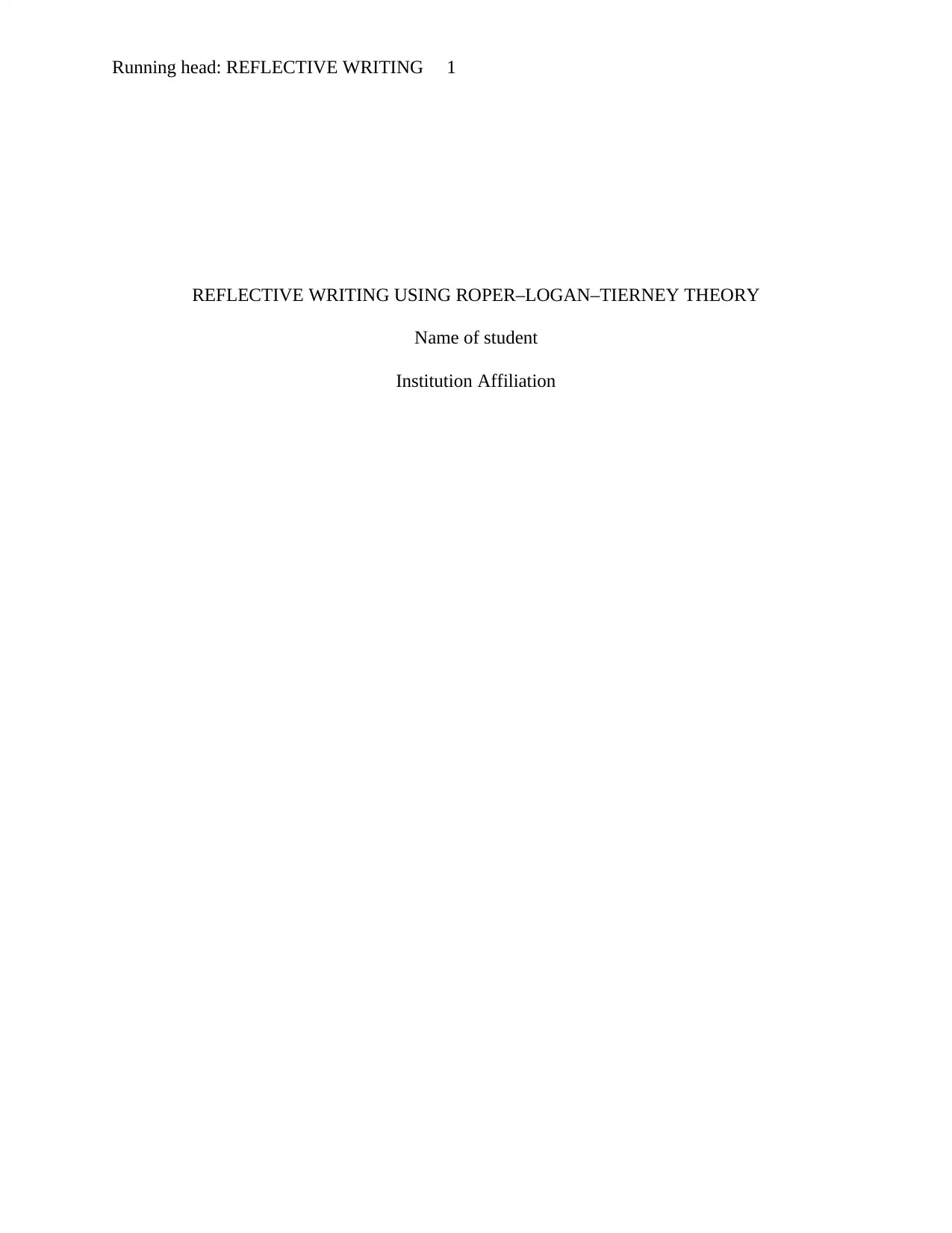
Running head: REFLECTIVE WRITING 1
REFLECTIVE WRITING USING ROPER–LOGAN–TIERNEY THEORY
Name of student
Institution Affiliation
REFLECTIVE WRITING USING ROPER–LOGAN–TIERNEY THEORY
Name of student
Institution Affiliation
Paraphrase This Document
Need a fresh take? Get an instant paraphrase of this document with our AI Paraphraser
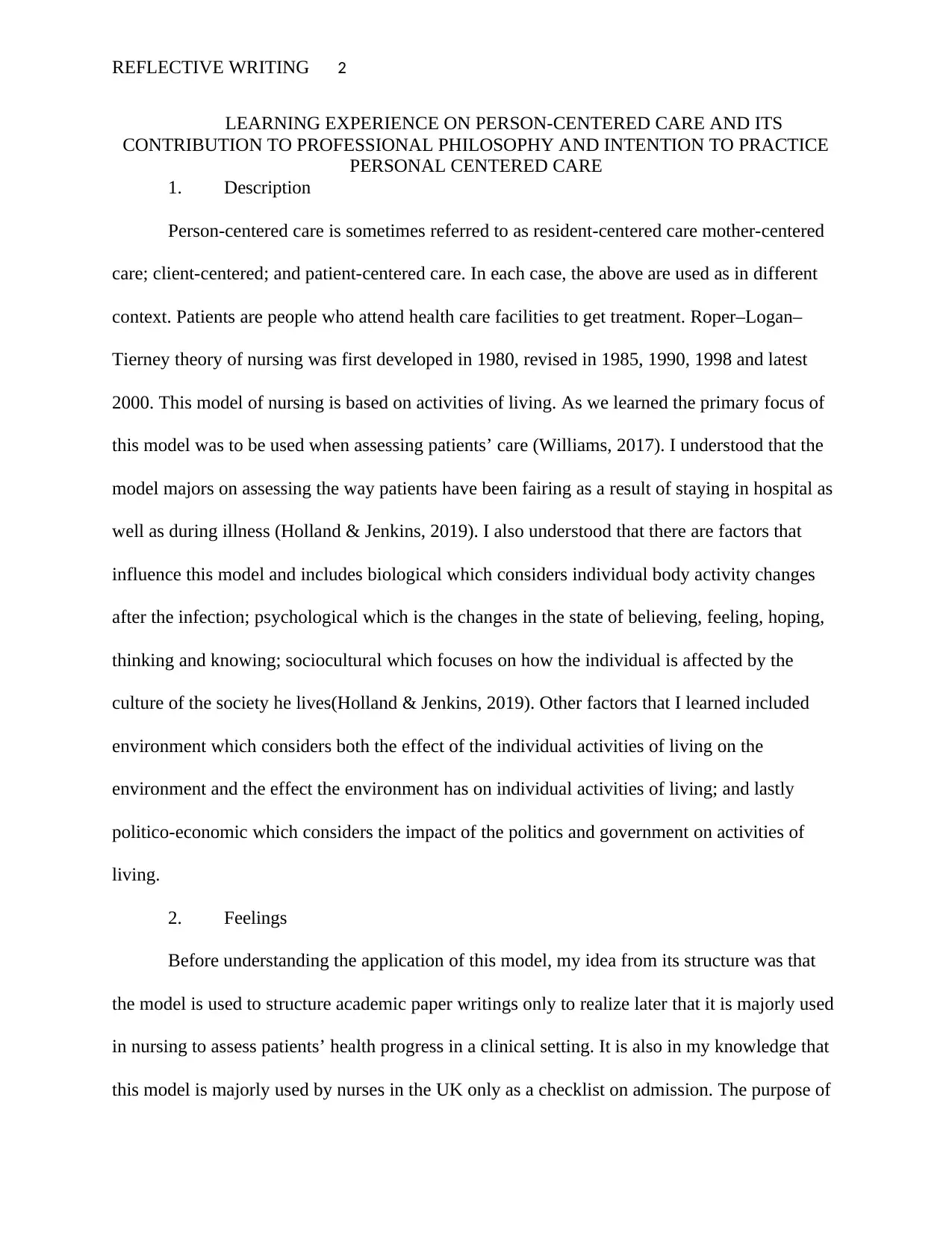
REFLECTIVE WRITING 2
LEARNING EXPERIENCE ON PERSON-CENTERED CARE AND ITS
CONTRIBUTION TO PROFESSIONAL PHILOSOPHY AND INTENTION TO PRACTICE
PERSONAL CENTERED CARE
1. Description
Person-centered care is sometimes referred to as resident-centered care mother-centered
care; client-centered; and patient-centered care. In each case, the above are used as in different
context. Patients are people who attend health care facilities to get treatment. Roper–Logan–
Tierney theory of nursing was first developed in 1980, revised in 1985, 1990, 1998 and latest
2000. This model of nursing is based on activities of living. As we learned the primary focus of
this model was to be used when assessing patients’ care (Williams, 2017). I understood that the
model majors on assessing the way patients have been fairing as a result of staying in hospital as
well as during illness (Holland & Jenkins, 2019). I also understood that there are factors that
influence this model and includes biological which considers individual body activity changes
after the infection; psychological which is the changes in the state of believing, feeling, hoping,
thinking and knowing; sociocultural which focuses on how the individual is affected by the
culture of the society he lives(Holland & Jenkins, 2019). Other factors that I learned included
environment which considers both the effect of the individual activities of living on the
environment and the effect the environment has on individual activities of living; and lastly
politico-economic which considers the impact of the politics and government on activities of
living.
2. Feelings
Before understanding the application of this model, my idea from its structure was that
the model is used to structure academic paper writings only to realize later that it is majorly used
in nursing to assess patients’ health progress in a clinical setting. It is also in my knowledge that
this model is majorly used by nurses in the UK only as a checklist on admission. The purpose of
LEARNING EXPERIENCE ON PERSON-CENTERED CARE AND ITS
CONTRIBUTION TO PROFESSIONAL PHILOSOPHY AND INTENTION TO PRACTICE
PERSONAL CENTERED CARE
1. Description
Person-centered care is sometimes referred to as resident-centered care mother-centered
care; client-centered; and patient-centered care. In each case, the above are used as in different
context. Patients are people who attend health care facilities to get treatment. Roper–Logan–
Tierney theory of nursing was first developed in 1980, revised in 1985, 1990, 1998 and latest
2000. This model of nursing is based on activities of living. As we learned the primary focus of
this model was to be used when assessing patients’ care (Williams, 2017). I understood that the
model majors on assessing the way patients have been fairing as a result of staying in hospital as
well as during illness (Holland & Jenkins, 2019). I also understood that there are factors that
influence this model and includes biological which considers individual body activity changes
after the infection; psychological which is the changes in the state of believing, feeling, hoping,
thinking and knowing; sociocultural which focuses on how the individual is affected by the
culture of the society he lives(Holland & Jenkins, 2019). Other factors that I learned included
environment which considers both the effect of the individual activities of living on the
environment and the effect the environment has on individual activities of living; and lastly
politico-economic which considers the impact of the politics and government on activities of
living.
2. Feelings
Before understanding the application of this model, my idea from its structure was that
the model is used to structure academic paper writings only to realize later that it is majorly used
in nursing to assess patients’ health progress in a clinical setting. It is also in my knowledge that
this model is majorly used by nurses in the UK only as a checklist on admission. The purpose of
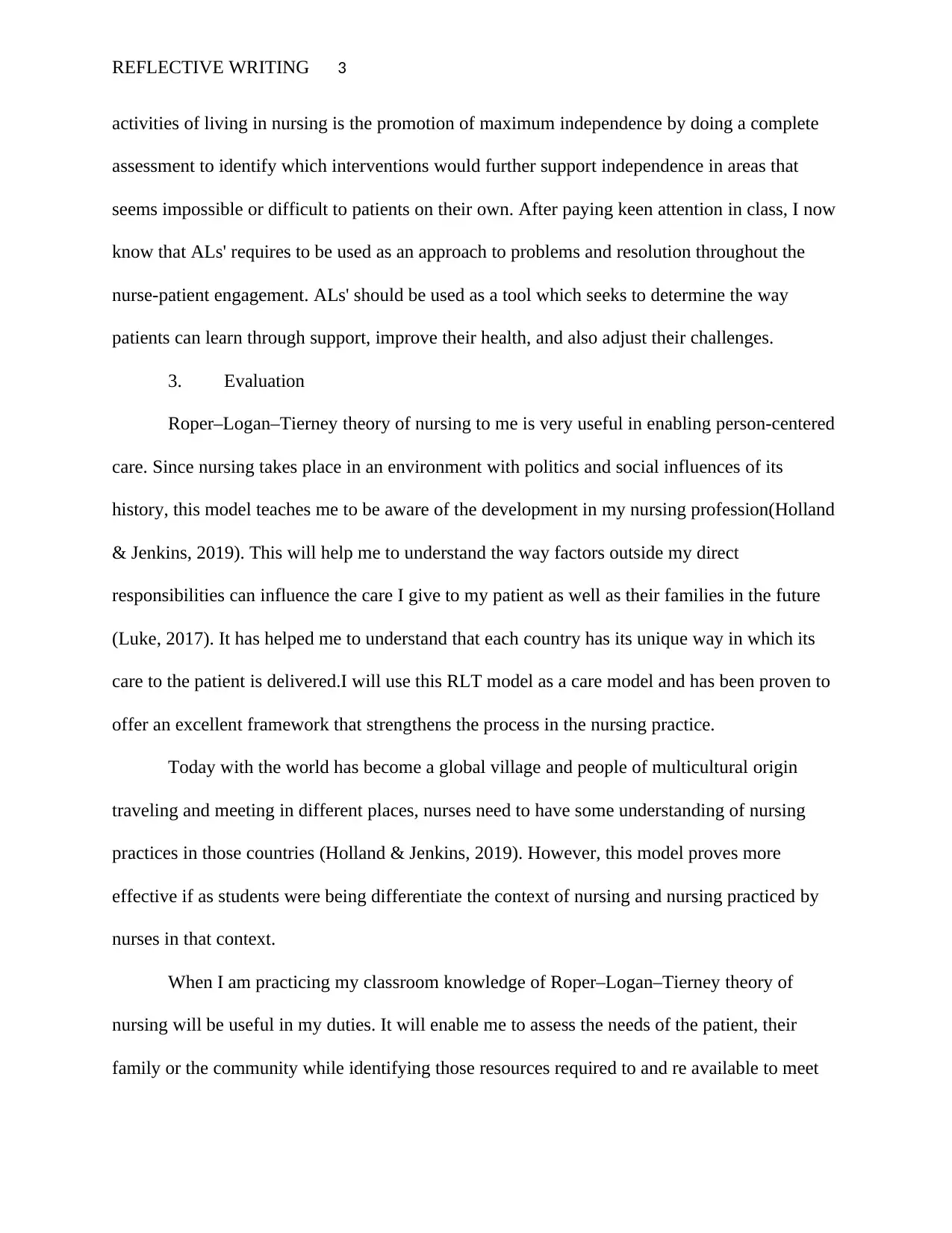
REFLECTIVE WRITING 3
activities of living in nursing is the promotion of maximum independence by doing a complete
assessment to identify which interventions would further support independence in areas that
seems impossible or difficult to patients on their own. After paying keen attention in class, I now
know that ALs' requires to be used as an approach to problems and resolution throughout the
nurse-patient engagement. ALs' should be used as a tool which seeks to determine the way
patients can learn through support, improve their health, and also adjust their challenges.
3. Evaluation
Roper–Logan–Tierney theory of nursing to me is very useful in enabling person-centered
care. Since nursing takes place in an environment with politics and social influences of its
history, this model teaches me to be aware of the development in my nursing profession(Holland
& Jenkins, 2019). This will help me to understand the way factors outside my direct
responsibilities can influence the care I give to my patient as well as their families in the future
(Luke, 2017). It has helped me to understand that each country has its unique way in which its
care to the patient is delivered.I will use this RLT model as a care model and has been proven to
offer an excellent framework that strengthens the process in the nursing practice.
Today with the world has become a global village and people of multicultural origin
traveling and meeting in different places, nurses need to have some understanding of nursing
practices in those countries (Holland & Jenkins, 2019). However, this model proves more
effective if as students were being differentiate the context of nursing and nursing practiced by
nurses in that context.
When I am practicing my classroom knowledge of Roper–Logan–Tierney theory of
nursing will be useful in my duties. It will enable me to assess the needs of the patient, their
family or the community while identifying those resources required to and re available to meet
activities of living in nursing is the promotion of maximum independence by doing a complete
assessment to identify which interventions would further support independence in areas that
seems impossible or difficult to patients on their own. After paying keen attention in class, I now
know that ALs' requires to be used as an approach to problems and resolution throughout the
nurse-patient engagement. ALs' should be used as a tool which seeks to determine the way
patients can learn through support, improve their health, and also adjust their challenges.
3. Evaluation
Roper–Logan–Tierney theory of nursing to me is very useful in enabling person-centered
care. Since nursing takes place in an environment with politics and social influences of its
history, this model teaches me to be aware of the development in my nursing profession(Holland
& Jenkins, 2019). This will help me to understand the way factors outside my direct
responsibilities can influence the care I give to my patient as well as their families in the future
(Luke, 2017). It has helped me to understand that each country has its unique way in which its
care to the patient is delivered.I will use this RLT model as a care model and has been proven to
offer an excellent framework that strengthens the process in the nursing practice.
Today with the world has become a global village and people of multicultural origin
traveling and meeting in different places, nurses need to have some understanding of nursing
practices in those countries (Holland & Jenkins, 2019). However, this model proves more
effective if as students were being differentiate the context of nursing and nursing practiced by
nurses in that context.
When I am practicing my classroom knowledge of Roper–Logan–Tierney theory of
nursing will be useful in my duties. It will enable me to assess the needs of the patient, their
family or the community while identifying those resources required to and re available to meet
⊘ This is a preview!⊘
Do you want full access?
Subscribe today to unlock all pages.

Trusted by 1+ million students worldwide
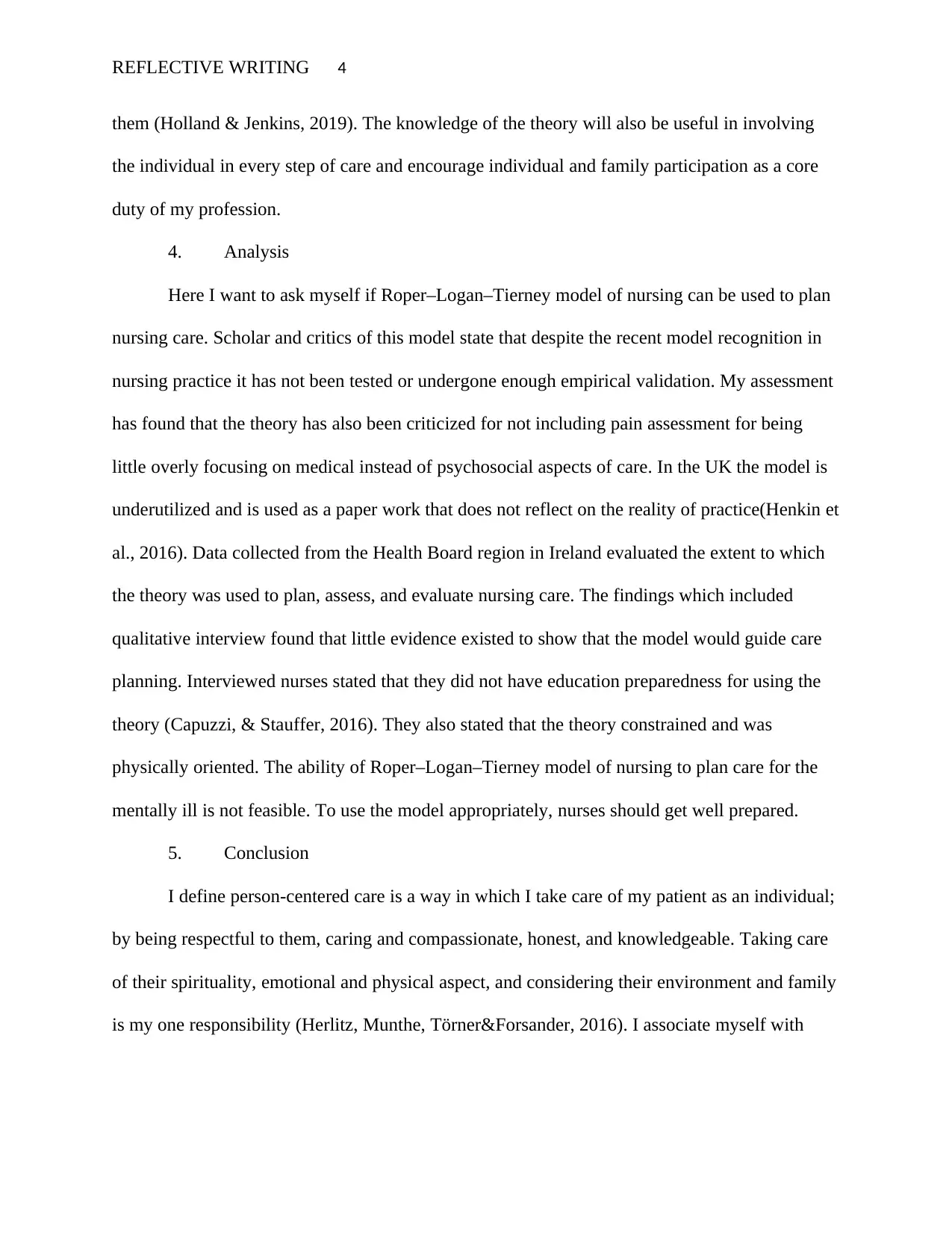
REFLECTIVE WRITING 4
them (Holland & Jenkins, 2019). The knowledge of the theory will also be useful in involving
the individual in every step of care and encourage individual and family participation as a core
duty of my profession.
4. Analysis
Here I want to ask myself if Roper–Logan–Tierney model of nursing can be used to plan
nursing care. Scholar and critics of this model state that despite the recent model recognition in
nursing practice it has not been tested or undergone enough empirical validation. My assessment
has found that the theory has also been criticized for not including pain assessment for being
little overly focusing on medical instead of psychosocial aspects of care. In the UK the model is
underutilized and is used as a paper work that does not reflect on the reality of practice(Henkin et
al., 2016). Data collected from the Health Board region in Ireland evaluated the extent to which
the theory was used to plan, assess, and evaluate nursing care. The findings which included
qualitative interview found that little evidence existed to show that the model would guide care
planning. Interviewed nurses stated that they did not have education preparedness for using the
theory (Capuzzi, & Stauffer, 2016). They also stated that the theory constrained and was
physically oriented. The ability of Roper–Logan–Tierney model of nursing to plan care for the
mentally ill is not feasible. To use the model appropriately, nurses should get well prepared.
5. Conclusion
I define person-centered care is a way in which I take care of my patient as an individual;
by being respectful to them, caring and compassionate, honest, and knowledgeable. Taking care
of their spirituality, emotional and physical aspect, and considering their environment and family
is my one responsibility (Herlitz, Munthe, Törner&Forsander, 2016). I associate myself with
them (Holland & Jenkins, 2019). The knowledge of the theory will also be useful in involving
the individual in every step of care and encourage individual and family participation as a core
duty of my profession.
4. Analysis
Here I want to ask myself if Roper–Logan–Tierney model of nursing can be used to plan
nursing care. Scholar and critics of this model state that despite the recent model recognition in
nursing practice it has not been tested or undergone enough empirical validation. My assessment
has found that the theory has also been criticized for not including pain assessment for being
little overly focusing on medical instead of psychosocial aspects of care. In the UK the model is
underutilized and is used as a paper work that does not reflect on the reality of practice(Henkin et
al., 2016). Data collected from the Health Board region in Ireland evaluated the extent to which
the theory was used to plan, assess, and evaluate nursing care. The findings which included
qualitative interview found that little evidence existed to show that the model would guide care
planning. Interviewed nurses stated that they did not have education preparedness for using the
theory (Capuzzi, & Stauffer, 2016). They also stated that the theory constrained and was
physically oriented. The ability of Roper–Logan–Tierney model of nursing to plan care for the
mentally ill is not feasible. To use the model appropriately, nurses should get well prepared.
5. Conclusion
I define person-centered care is a way in which I take care of my patient as an individual;
by being respectful to them, caring and compassionate, honest, and knowledgeable. Taking care
of their spirituality, emotional and physical aspect, and considering their environment and family
is my one responsibility (Herlitz, Munthe, Törner&Forsander, 2016). I associate myself with
Paraphrase This Document
Need a fresh take? Get an instant paraphrase of this document with our AI Paraphraser
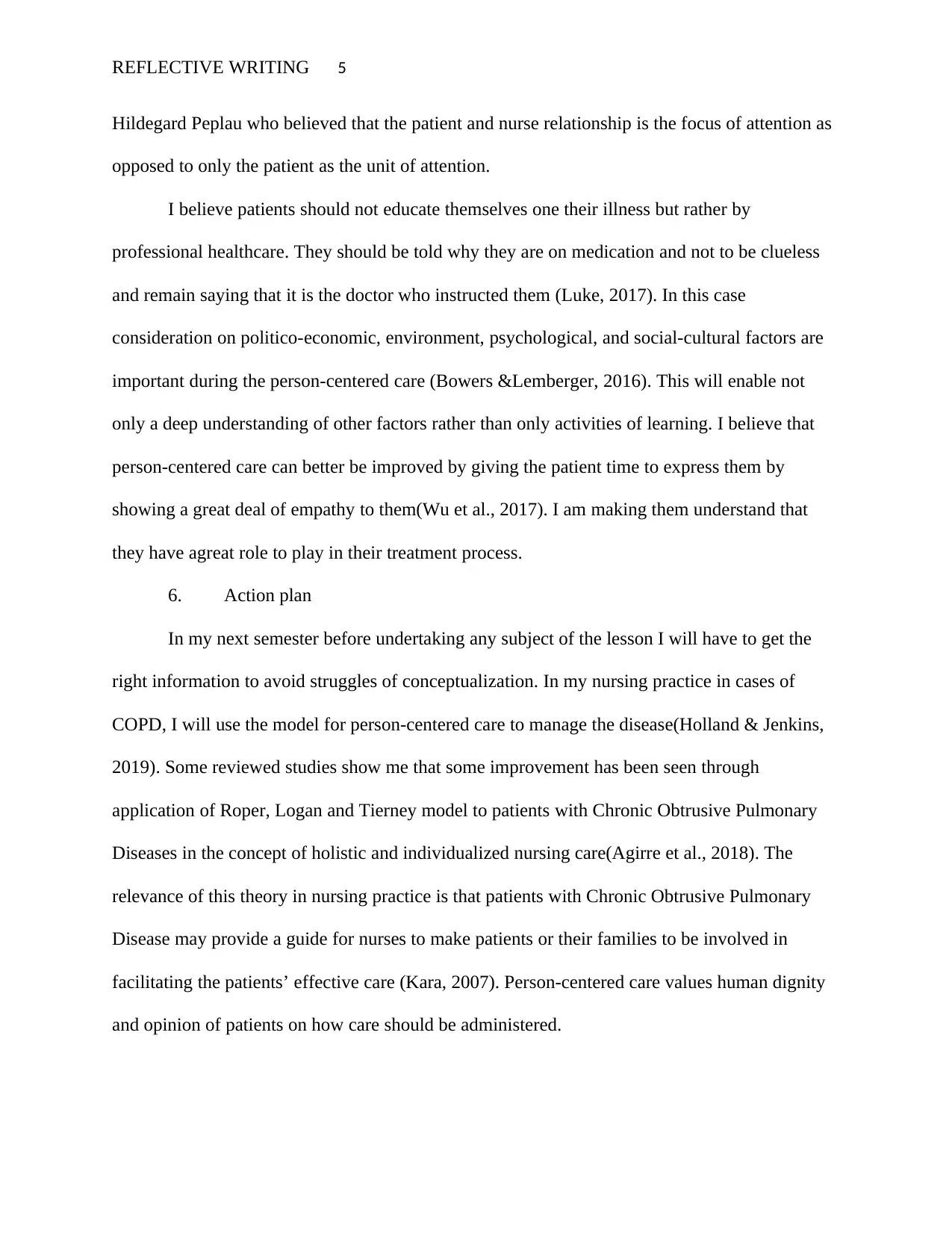
REFLECTIVE WRITING 5
Hildegard Peplau who believed that the patient and nurse relationship is the focus of attention as
opposed to only the patient as the unit of attention.
I believe patients should not educate themselves one their illness but rather by
professional healthcare. They should be told why they are on medication and not to be clueless
and remain saying that it is the doctor who instructed them (Luke, 2017). In this case
consideration on politico-economic, environment, psychological, and social-cultural factors are
important during the person-centered care (Bowers &Lemberger, 2016). This will enable not
only a deep understanding of other factors rather than only activities of learning. I believe that
person-centered care can better be improved by giving the patient time to express them by
showing a great deal of empathy to them(Wu et al., 2017). I am making them understand that
they have agreat role to play in their treatment process.
6. Action plan
In my next semester before undertaking any subject of the lesson I will have to get the
right information to avoid struggles of conceptualization. In my nursing practice in cases of
COPD, I will use the model for person-centered care to manage the disease(Holland & Jenkins,
2019). Some reviewed studies show me that some improvement has been seen through
application of Roper, Logan and Tierney model to patients with Chronic Obtrusive Pulmonary
Diseases in the concept of holistic and individualized nursing care(Agirre et al., 2018). The
relevance of this theory in nursing practice is that patients with Chronic Obtrusive Pulmonary
Disease may provide a guide for nurses to make patients or their families to be involved in
facilitating the patients’ effective care (Kara, 2007). Person-centered care values human dignity
and opinion of patients on how care should be administered.
Hildegard Peplau who believed that the patient and nurse relationship is the focus of attention as
opposed to only the patient as the unit of attention.
I believe patients should not educate themselves one their illness but rather by
professional healthcare. They should be told why they are on medication and not to be clueless
and remain saying that it is the doctor who instructed them (Luke, 2017). In this case
consideration on politico-economic, environment, psychological, and social-cultural factors are
important during the person-centered care (Bowers &Lemberger, 2016). This will enable not
only a deep understanding of other factors rather than only activities of learning. I believe that
person-centered care can better be improved by giving the patient time to express them by
showing a great deal of empathy to them(Wu et al., 2017). I am making them understand that
they have agreat role to play in their treatment process.
6. Action plan
In my next semester before undertaking any subject of the lesson I will have to get the
right information to avoid struggles of conceptualization. In my nursing practice in cases of
COPD, I will use the model for person-centered care to manage the disease(Holland & Jenkins,
2019). Some reviewed studies show me that some improvement has been seen through
application of Roper, Logan and Tierney model to patients with Chronic Obtrusive Pulmonary
Diseases in the concept of holistic and individualized nursing care(Agirre et al., 2018). The
relevance of this theory in nursing practice is that patients with Chronic Obtrusive Pulmonary
Disease may provide a guide for nurses to make patients or their families to be involved in
facilitating the patients’ effective care (Kara, 2007). Person-centered care values human dignity
and opinion of patients on how care should be administered.
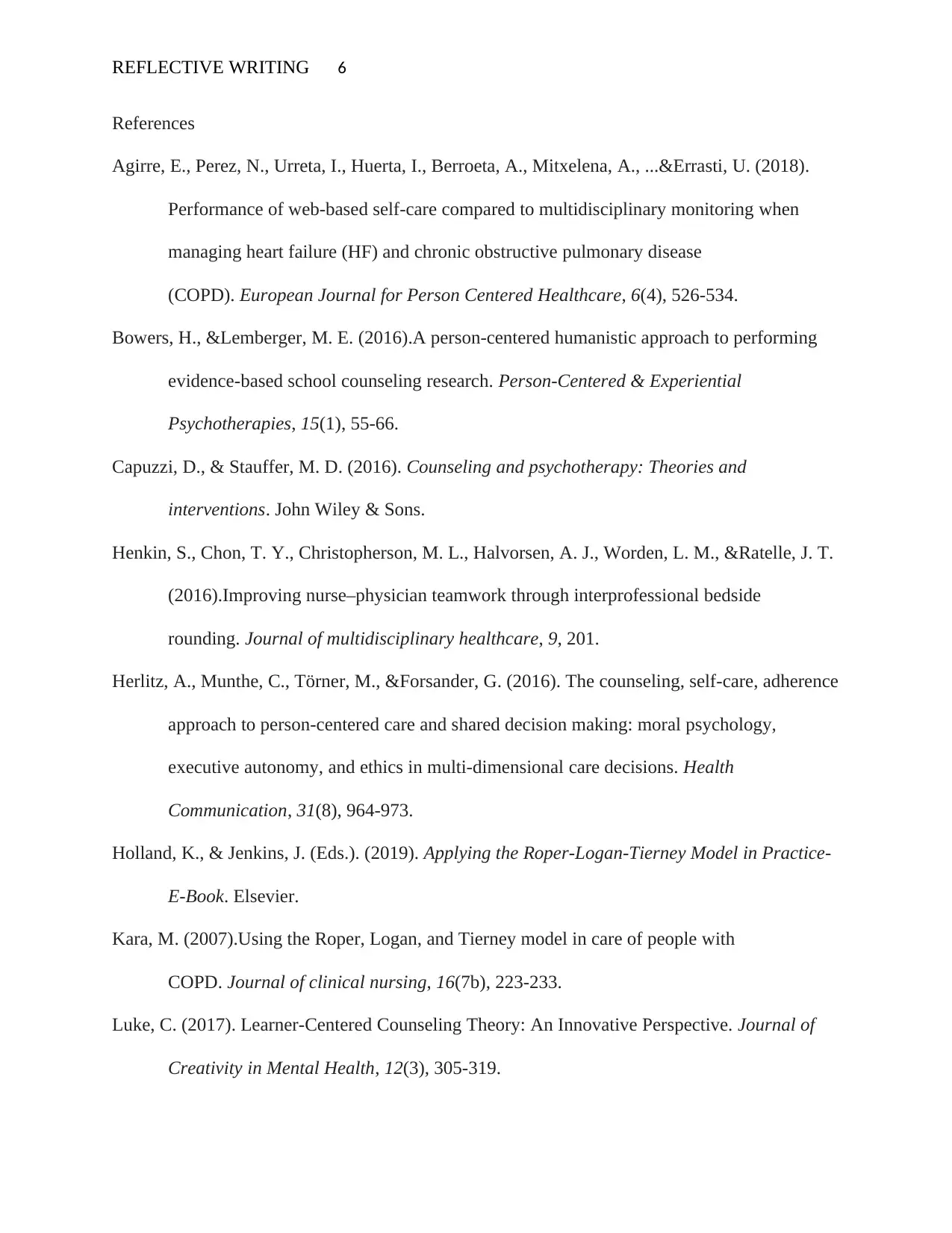
REFLECTIVE WRITING 6
References
Agirre, E., Perez, N., Urreta, I., Huerta, I., Berroeta, A., Mitxelena, A., ...&Errasti, U. (2018).
Performance of web-based self-care compared to multidisciplinary monitoring when
managing heart failure (HF) and chronic obstructive pulmonary disease
(COPD). European Journal for Person Centered Healthcare, 6(4), 526-534.
Bowers, H., &Lemberger, M. E. (2016).A person-centered humanistic approach to performing
evidence-based school counseling research. Person-Centered & Experiential
Psychotherapies, 15(1), 55-66.
Capuzzi, D., & Stauffer, M. D. (2016). Counseling and psychotherapy: Theories and
interventions. John Wiley & Sons.
Henkin, S., Chon, T. Y., Christopherson, M. L., Halvorsen, A. J., Worden, L. M., &Ratelle, J. T.
(2016).Improving nurse–physician teamwork through interprofessional bedside
rounding. Journal of multidisciplinary healthcare, 9, 201.
Herlitz, A., Munthe, C., Törner, M., &Forsander, G. (2016). The counseling, self-care, adherence
approach to person-centered care and shared decision making: moral psychology,
executive autonomy, and ethics in multi-dimensional care decisions. Health
Communication, 31(8), 964-973.
Holland, K., & Jenkins, J. (Eds.). (2019). Applying the Roper-Logan-Tierney Model in Practice-
E-Book. Elsevier.
Kara, M. (2007).Using the Roper, Logan, and Tierney model in care of people with
COPD. Journal of clinical nursing, 16(7b), 223-233.
Luke, C. (2017). Learner-Centered Counseling Theory: An Innovative Perspective. Journal of
Creativity in Mental Health, 12(3), 305-319.
References
Agirre, E., Perez, N., Urreta, I., Huerta, I., Berroeta, A., Mitxelena, A., ...&Errasti, U. (2018).
Performance of web-based self-care compared to multidisciplinary monitoring when
managing heart failure (HF) and chronic obstructive pulmonary disease
(COPD). European Journal for Person Centered Healthcare, 6(4), 526-534.
Bowers, H., &Lemberger, M. E. (2016).A person-centered humanistic approach to performing
evidence-based school counseling research. Person-Centered & Experiential
Psychotherapies, 15(1), 55-66.
Capuzzi, D., & Stauffer, M. D. (2016). Counseling and psychotherapy: Theories and
interventions. John Wiley & Sons.
Henkin, S., Chon, T. Y., Christopherson, M. L., Halvorsen, A. J., Worden, L. M., &Ratelle, J. T.
(2016).Improving nurse–physician teamwork through interprofessional bedside
rounding. Journal of multidisciplinary healthcare, 9, 201.
Herlitz, A., Munthe, C., Törner, M., &Forsander, G. (2016). The counseling, self-care, adherence
approach to person-centered care and shared decision making: moral psychology,
executive autonomy, and ethics in multi-dimensional care decisions. Health
Communication, 31(8), 964-973.
Holland, K., & Jenkins, J. (Eds.). (2019). Applying the Roper-Logan-Tierney Model in Practice-
E-Book. Elsevier.
Kara, M. (2007).Using the Roper, Logan, and Tierney model in care of people with
COPD. Journal of clinical nursing, 16(7b), 223-233.
Luke, C. (2017). Learner-Centered Counseling Theory: An Innovative Perspective. Journal of
Creativity in Mental Health, 12(3), 305-319.
⊘ This is a preview!⊘
Do you want full access?
Subscribe today to unlock all pages.

Trusted by 1+ million students worldwide
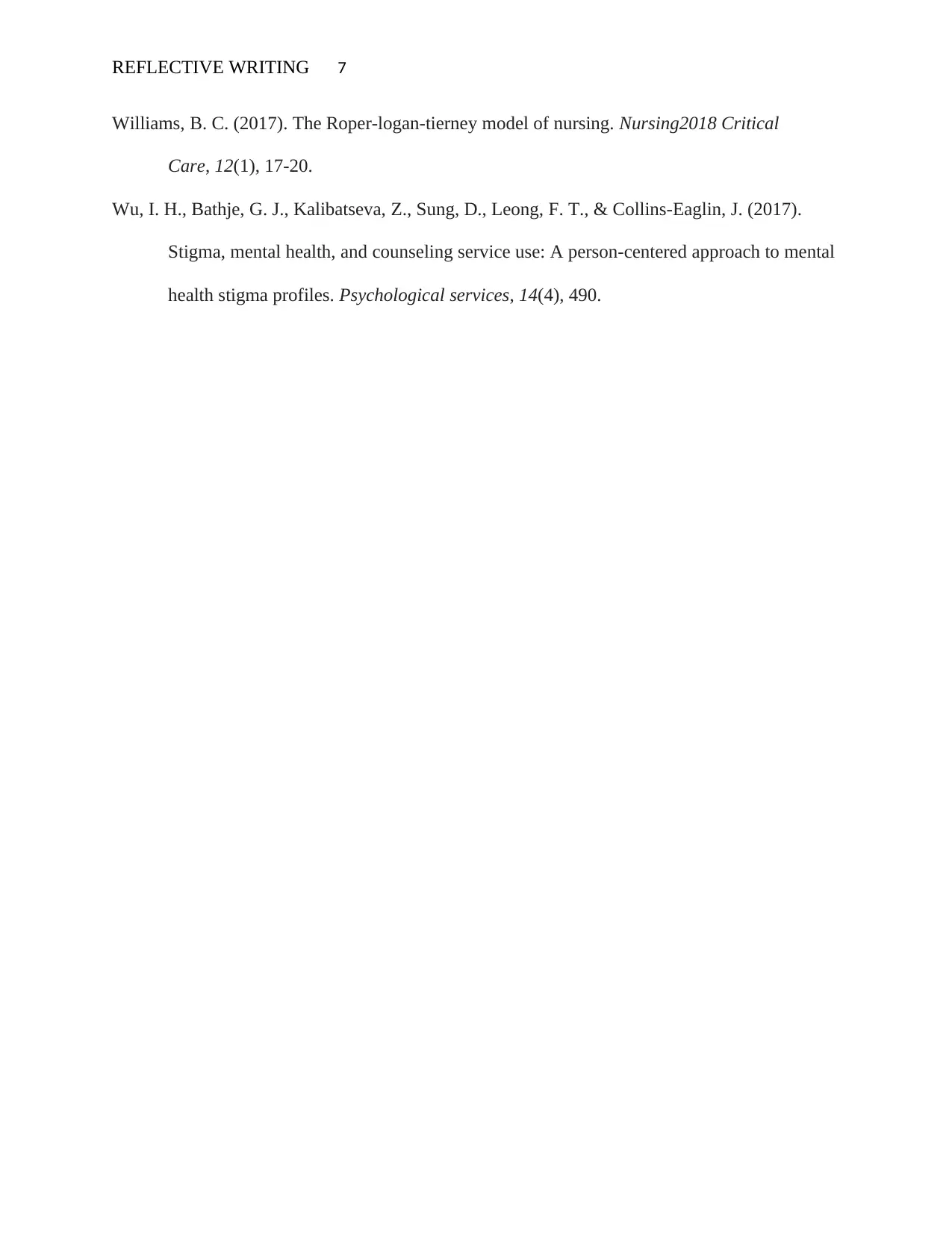
REFLECTIVE WRITING 7
Williams, B. C. (2017). The Roper-logan-tierney model of nursing. Nursing2018 Critical
Care, 12(1), 17-20.
Wu, I. H., Bathje, G. J., Kalibatseva, Z., Sung, D., Leong, F. T., & Collins-Eaglin, J. (2017).
Stigma, mental health, and counseling service use: A person-centered approach to mental
health stigma profiles. Psychological services, 14(4), 490.
Williams, B. C. (2017). The Roper-logan-tierney model of nursing. Nursing2018 Critical
Care, 12(1), 17-20.
Wu, I. H., Bathje, G. J., Kalibatseva, Z., Sung, D., Leong, F. T., & Collins-Eaglin, J. (2017).
Stigma, mental health, and counseling service use: A person-centered approach to mental
health stigma profiles. Psychological services, 14(4), 490.
1 out of 7
Related Documents
Your All-in-One AI-Powered Toolkit for Academic Success.
+13062052269
info@desklib.com
Available 24*7 on WhatsApp / Email
![[object Object]](/_next/static/media/star-bottom.7253800d.svg)
Unlock your academic potential
Copyright © 2020–2025 A2Z Services. All Rights Reserved. Developed and managed by ZUCOL.




